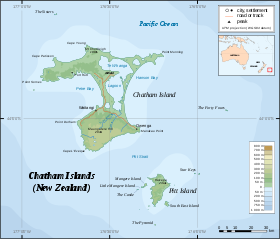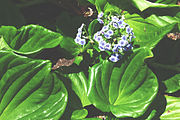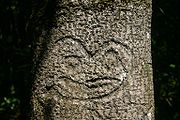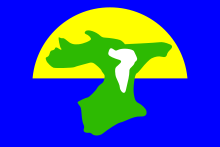- Chatham Islands
-
This article is about an island group of New Zealand. For other islands with this or similar names, see Chatham Island (disambiguation).
Chatham Islands Native name: Rekohu, Wharekauri 
Topographical map of the Chatham Islands
Map locating the Chatham IslandsGeography Location Southern Pacific Ocean Coordinates 44°02′S 176°26′W / 44.033°S 176.433°WCoordinates: 44°02′S 176°26′W / 44.033°S 176.433°W Archipelago Chatham Islands Total islands 10 Major islands Chatham Island, Pitt Island Area 966 km2 (373 sq mi) Highest elevation 294 m (965 ft) Highest point Maungatere Hill Country Largest city Waitangi Demographics Population 650 (According to Chatham Islands Council)  The Chatham Islands from space. Chatham Island is the largest, Pitt Island is the second largest, and South East Island is the small island to the right of Pitt
The Chatham Islands from space. Chatham Island is the largest, Pitt Island is the second largest, and South East Island is the small island to the right of Pitt
The Chatham Islands (Moriori: Rekohu, Māori: 'Wharekauri') are an archipelago and New Zealand territory in the Pacific Ocean consisting of about ten islands within a 40 kilometres (25 mi) radius, the largest of which are Chatham Island and Pitt Island. Their name in the indigenous language, Moriori, means Misty Sun. These remote islands, over 800 kilometres (500 mi) east of southern New Zealand, have officially been part of New Zealand since 1842.
Contents
Geography
The islands are at about 43°53′S 176°31′W / 43.883°S 176.517°W, roughly 800 kilometres (500 mi) east of Christchurch, New Zealand. They cover a total of 966 square kilometres (373 sq mi), almost all of which is in the two main islands.
The islands sit on the Chatham Rise, a large, relatively shallowly submerged (no more than 1,000 metres / 3,281 feet deep at any point) part of the Zealandia continent that stretches east from near the South Island. The Chatham Islands, which emerged only within the last four million years, are the only part of the Chatham Rise showing above sea level.[1]
The islands are generally hilly with the coasts a varied mixture including cliffs and sand dunes, beaches and lagoons. Pitt is more rugged than Chatham (Rekohu), although the highest point (299 metres / 981 feet) is on a plateau near the southernmost point of the main island, which is dotted with numerous lakes and lagoons, notably the large Te Whanga Lagoon as well as Huro and Rangitahi. Chatham has a number of streams including Te Awainanga and Tuku. The climate is cold, wet and windy with average high temperatures between 5 °C (41 °F) and 10 °C (50 °F) in July, the southern hemisphere winter.
Chatham and Pitt are the only inhabited islands, with the remaining smaller islands being conservation reserves with access restricted or prohibited. The livelihoods of the inhabitants depend on agriculture, with the island being an exporter of coldwater crayfish in particular, and increasing tourism.
The names of the main islands, in the order of occupation are:
English name Moriori name Maori name Remarks Chatham Island Rekohu Wharekauri Pitt Island Rangiaotea Rangiauria South East Island Rangatira Rangatira The Fort Unknown Mangere The Maori name has supplanted the English name for this island. Little Mangere Unknown Tapuenuku Star Keys Motuhope Motuhope The Sisters Rangitatahi Rangitatahi about 16 kilometres (9.9 mi) north of Cape Pattison, a headland in the northwestern part of Chatham Island The Forty-Fours Motuhara the easternmost point of New Zealand, about 50 kilometres (31 mi) from Chatham Island. The international date line lies to the east of the Chathams, even though the islands lie east of 180° longitude. Consequently, the Chathams observe their own time, 45 minutes ahead of New Zealand time, including during periods of daylight saving; their time zone is distinctive as one of very few which differ from others by a period other than a whole hour or half-hour. (New Zealand Time orients itself to 180° longitude). Chatham Island is the antipodes of the French department of Hérault (Languedoc-Roussillon).
Climate data for Chatham Islands Month Jan Feb Mar Apr May Jun Jul Aug Sep Oct Nov Dec Year Average high °C (°F) 17.8
(64.0)18.1
(64.6)17.1
(62.8)15.1
(59.2)12.8
(55.0)11.1
(52.0)10.4
(50.7)10.9
(51.6)11.8
(53.2)13.1
(55.6)14.5
(58.1)16.5
(61.7)14.1 Daily mean °C (°F) 14.7
(58.5)15.1
(59.2)14.2
(57.6)12.5
(54.5)10.2
(50.4)8.7
(47.7)8.0
(46.4)8.5
(47.3)9.3
(48.7)10.5
(50.9)11.8
(53.2)13.7
(56.7)11.0 Average low °C (°F) 11.7
(53.1)12.1
(53.8)11.3
(52.3)9.8
(49.6)7.7
(45.9)6.4
(43.5)5.5
(41.9)6.1
(43.0)6.8
(44.2)7.9
(46.2)9.1
(48.4)10.9
(51.6)8.8 Rainfall mm (inches) 54
(2.13)55
(2.17)74
(2.91)70
(2.76)93
(3.66)99
(3.9)95
(3.74)76
(2.99)71
(2.8)63
(2.48)59
(2.32)55
(2.17)855
(33.66)% humidity 80.1 83.1 81.7 82.6 84.1 84.3 84.5 83.2 82.9 83.5 80.2 80.3 82.4 Avg. rainy days (≥ 1mm) 8 7 10 10 15 15 16 14 12 10 9 8 133 Sunshine hours 179 143 122 99 79 63 55 93 106 136 152 162 1,415 Source: NIWA CliFlo data Musselburgh[2] Subdivision
The Chatham Islands are subdivided into seven survey districts:
- Rangitihi Survey District 43°41′50″S 176°37′46″W / 43.69722°S 176.62944°W (north)
- Rekohu Survey District 43°44′11″S 176°20′48″W / 43.73639°S 176.34667°W (northeast)
- Tawirikoko Survey District 43°48′37″S 176°50′00″W / 43.81028°S 176.8333333°W (northwest)
- Te Whanga Survey District 43°49′26″S 176°32′26″W / 43.82389°S 176.54056°W (center-north)
- Oropuke Survey District 44°01′28″S 176°36′53″W / 44.02444°S 176.61472°W (south)
- Rangimene Survey District 44°02′28″S 176°19′58″W / 44.04111°S 176.33278°W (southeast)
- Rangiuria Survey District 44°16′49″S 176°14′58″W / 44.28028°S 176.24944°W (Pitt Island)
Ecology
The natural vegetation of the islands was a mixture of forest, scrubby heath and swamp, but today most of the land is fern or pasture covered, although there are some areas of dense forest and areas of peat bogs and other habitats. Of interest are the macrocarpa trees, with branches trailing almost horizontally in the lee of the wind. The ferns in the forest understory include Blechnum discolor.
The islands are home to a rich bio-diversity including about fifty endemic plants adapted to the cold and the wind, of which Chatham Islands forget-me-not (Myosotidium hortensia), Chatham Islands Sow-thistle (Embergeria grandifolia), rautini (Brachyglottis huntii), Chatham Islands kakaha (Astelia chathamica) , soft speargrass (Aciphylla dieffenbachii) and Chatham Island akeake or Chatham Island tree daisy (Olearia traversiorum) are among the best-known.
The islands are a breeding ground for huge flocks of seabirds and are home to number of endemic birds, some of them seabirds and some of them living on the islands themselves. The best known species are the Magenta Petrel and the Black Robin, both of which came perilously close to extinction before being subjected to conservation efforts. Other endemic species are the Chatham Island Oystercatcher, the Chatham Gerygone, the Parea or Chatham Islands Pigeon, Forbes' Parakeet, the Chatham Snipe and the Shore Plover. A number of species have also gone extinct since European settlement, including the three endemic species of rail, Chatham Islands Raven and the Chatham Islands Fernbird.
There are also a number of endemic insects while mammals found in the waters of the Chathams include New Zealand Sea Lion, Leopard Seal, and Southern Elephant Seal.
Much of the natural forest of these islands has been cleared for farming, but Mangere and Rangatira Islands are now preserved as nature reserves to conserve some of this unique flora and fauna. Another threat to wildlife here comes from introduced species which prey on the indigenous birds and reptiles, whereas on Mangere and Rangatira livestock has been removed and native wildlife is recovering.
History
The first human habitation of the Chathams involved migrating Polynesian tribes who settled the islands about 1500 CE,[3] and in their isolation became the Moriori people. The belief as to their origins was overturned late in the 20th century. The former belief, which arose in the 1800s, was that the original Moriori migrated directly from more northerly Polynesian islands, just as with the settlement of New Zealand by the ancestors of the Māori. However, linguistic research indicates instead that the ancestral Moriori were Māori wanderers from New Zealand.[4][5][6][7] As Howe (2003) puts it,
Scholarship over the past 40 years has radically revised the model offered a century earlier by Smith: the Moriori as a pre-Polynesian people have gone (the term Moriori is now a technical term referring to those ancestral Maori who settled the Chatham Islands).'[8]
The plants cultivated by the Māori arrivals were ill suited for the colder Chathams, so the Moriori lived as hunter-gatherers and fishermen. While their new environment deprived them of the resources with which to build ocean-going craft for long voyages, the Moriori invented what was known as the waka korari, a semi-submerged craft, constructed of flax and lined with air bladders from kelp. This craft was used to travel to the outer islands on 'birding' missions (King. M, 1989, Moriori, a people Rediscovered). The Moriori society was a peaceful society and bloodshed was outlawed by the chief Nunuku after generations of warfare. Arguments were solved by consensus or by duels rather than warfare, but at the first sign of bloodshed, the fight was over.
The name "Chatham Islands" comes from the ship HMS Chatham of the Vancouver Expedition, whose captain William R. Broughton landed on 29 November 1791, claimed possession for Great Britain and named the islands after the First Lord of the Admiralty, John Pitt, 2nd Earl of Chatham. A relative of his, Thomas Pitt, was a member of the Vancouver Expedition. Sealers and whalers soon started hunting in the surrounding ocean with the islands as their base. It is estimated that 10 to 20 percent of the indigenous population soon died from diseases introduced by foreigners. The sealing and whaling industries ceased activities about 1861, while fishing remained as a major economic activity.
The Māori conquest and genocide
On 19 November 1835, a British mercenary ship carrying 500 Māori armed with guns, clubs and axes arrived, followed by another ship on 5 December 1835 with a further 400 Māori. The Maori came from two tribes, the Tama and Mutunga. They proceeded to massacre the Moriori, who are thought to have numbered about 2,000, cannibalise the dead and enslave the survivors. A Moriori survivor recalled: "[The Māori] commenced to kill us like sheep.... [We] were terrified, fled to the bush, concealed ourselves in holes underground, and in any place to escape our enemies. It was of no avail; we were discovered and killed - men, women and children indiscriminately". A Māori conqueror justified their actions as follows: "We took possession... in accordance with our customs and we caught all the people. Not one escaped....."[9]
After the invasion, Moriori were forbidden to marry Moriori, nor to have children with each other. All became slaves of the invaders until the 1860s.[10] Many died in despair. Many Moriori women had children by their Māori masters. A number of Moriori women eventually married either Māori or European men. Some were taken from the Chathams and never returned.
An all-male group of German Lutheran missionaries arrived in 1843. After a group of women were sent out to join them three years later several marriages ensued, and many members of the present-day population can trace their ancestry back to the missionary families.
In 1865 the Māori leader Te Kooti was exiled on the Chatham Islands.
Present day conditions
The Moriori community is organized as the Hokotehi Moriori Trust.[11] The Moriori have received recognition from the Crown and the New Zealand government and some of their claims against those institutions for the generations of neglect and oppression have been accepted and acted on. Moriori are recognised as the original people of Rekohu. The Crown also recognised the invading Maori tribe: Ngati Mutunga[12] as having "indigenous" status in the Chathams by right of 160-odd years of occupation.
The population of the islands is 650, including members of both ethnic groups. In January 2005 the Moriori celebrated the opening of the new Kopinga Marae (meeting house).
Modern descendants of the 1835 Māori conquerors claimed to share in ancestral Māori fishing rights. This claim was granted. Now that the primordial population, the Moriori, have been recognized to be former Maori—over the objections of the Mutunga—they too share in the ancestral Maori fishing rights. Both groups have been granted fishing quotas.
Population
Chatham and Pitt Islands are inhabited, with 609 residents in the 2006 Census.[13] The town of Waitangi is the main settlement with some 200 residents. There are other villages such as Owenga, Te One and Kaingaroa, where there are two primary schools. A third school is on Pitt Island. There are also the fishing villages of Owenga and Port Hutt. The population is mainly of European, Māori and Moriori background; 64% said they identified as Māori (which includes Moriori), and around 75% identified as European or New Zealander.[14]
Waitangi facilities include a hospital with resident doctor, bank, several stores, and engineering and marine services. The main shipping wharf is located here.
Transport
Visitors to the Chathams usually arrive by air from Christchurch, Auckland or Wellington (around 1.5 – 2 hours from Christchurch on a Convair 580) to the airport on Chatham Island. While freight generally arrives by ship (4–5 days' sailing time), the sea journey takes too long for many passengers, and is not always available.
The Chathams are part of New Zealand so there are no border controls or formalities on arrival, but visitors are advised to have prearranged their accommodation on the islands. Transport operators may refuse to carry passengers without accommodation bookings. There is no scheduled public transport but accommodation providers are normally able to arrange transport.
For many years a Bristol Freighter served the islands, a slow and noisy freight aircraft converted for carrying passengers by installing a passenger container equipped with airline seats and a toilet in part of the cargo hold. The air service primarily served to ship out high-value export crayfish products.
The grass landing-field at Hapupu, at the northern end of the Island, proved a limiting factor, as few aircraft apart from the Bristol Freighter had both the range to fly to the islands and the ruggedness to land on the grass airstrip. Although other aircraft did use the landing field occasionally, they would often require repairs to fix damage resulting from the rough landing. Hapupu is also the site of the JM Barker (Hapupu) National Historic Reserve (one of only two in New Zealand) where there are momori rakau (Moriori tree carvings).
In 1981, after many years of requests by locals and the imminent demise of the aging Bristol Freighter aircraft, the construction of a sealed runway at Karewa, Tuuta Airport, allowed more modern aircraft to land safely. The Chathams' own airline, Air Chathams, now operates services to Auckland on Thursdays, Wellington on Mondays, Wednesdays and Fridays and Christchurch on Tuesdays. The timetable varies seasonally, but generally planes depart the Chathams around 10.30 am (Chathams Time) and arrive in the mainland around noon. There they refuel and reload, and depart again at around 1 pm back to the Chathams. Air Chathams operates twin turboprop Convair 580 aircraft in combi (freight and passenger) configurations and Fairchild Metroliners.
Black Robin Freighters operates shipping services from Timaru.
There is a small section of tar sealed road between Waitangi and Te One, but the majority of the island's roads are gravel.
Government
Electorates
Until the 1980s the Chathams were in the Lyttelton electorate, but since then they have formed part of the Rongotai general electorate, which mostly lies in Wellington. Annette King is the MP for Rongotai. The Te Tai Tonga Māori seat (held since 2008 by Rahui Katene) includes the Chatham Islands.
Local government
Local government on the islands, uniquely within New Zealand, involves a council established by its own Act of Parliament, the Chatham Islands Council Act 1995 (Statute No 041, Commenced: 1 November 1995).[15] The Chatham Islands Council operates as a district council with regional council functions, making it in effect a unitary authority but with not quite as many responsibilities as the others. Some Regional Council functions are being administered by Environment Canterbury, the Canterbury Regional Council.
In the 2010 local government elections, Chatham Islands had NZ's highest rate of returned votes, with 71.3 percent voting.[16]
State services
Policing is carried out by a sole-charge constable appointed by the Wellington police district, who has often doubled as an official for many government departments, including court registrar (Department for Courts), customs officer (New Zealand Customs Service) and immigration officer (Department of Labour - New Zealand Immigration Service).
A District Court judge sent from either the North Island or the South Island presides over court sittings, but urgent sittings may take place at the Wellington District Court.
Because of the isolation and small population, some of the rules governing daily activities undergo a certain relaxation. For example, every transport service operated solely on Great Barrier Island, the Chatham Islands or Stewart Island/Rakiura need not comply with section 70C of the Transport Act 1962 (the requirements for drivers to maintain driving-hours logbooks). Drivers subject to section 70B must nevertheless keep record of their driving hours in some form.[17]
Health
The partially-elected Hawke's Bay District Health Board provides the islands with health services.
Education
There are three schools on the Chathams, at Kaingaroa, Te One and Pitt Island. Pitt Island and Kaingaroa are staffed by sole charge principals while Te One has three teachers and a principal. These schools cater for children from Year 1 to 8. There is no secondary school on the Chathams. The majority of secondary school aged students leave the island for boarding schools in New Zealand. A small number remain on the island and carry out their secondary education through correspondence.
Economy
Most of the Chatham Island economy is based on fishing and crabbing, with only a fragment of adventure tourism. This economic mix has been stable for the past 50 years, as there is little infrastructure or population to engage in higher levels of industrial or telecommunications activity.
Electricity generation
At present, the island is powered by two 200 kW wind turbines to provide most of the power on the island while diesel generators provide the rest.
In popular culture
Fiction
- In Jules Verne's Robur the Conqueror, Robur anchors his flying vessel Albatross over the Chathams after the horizontal propellers are damaged in a storm.
- The novel Cloud Atlas includes the diary of a fictitious 19th century American traveller who passes through the Chathams.
- In Joe Buff's futuristic nuclear submarine warfare book Crush Depth (ISBN 0-06-000964-0), Chatham Island is destroyed by an Axis planted atomic bomb.
Television
The TVNZ series How the Other Half Lives (2008) had a segment on the Chatham Islands.
See also
References
- ^ McGlone, Matt (21 September 2007). "Ecoregions: The Chatham Islands". Te Ara – the Encyclopedia of New Zealand. http://www.teara.govt.nz/TheBush/UnderstandingTheNaturalWorld/Ecoregions/9/en. Retrieved 2009-02-08.
- ^ "CliFlo data Musselburgh (5402, 15752)". NIWA. http://www.niwa.co.nz/. Retrieved 2011-05-09.
- ^ McFadgen 1994
- ^ Clark 1994: 123–135.
- ^ Davis and Solomon 2006
- ^ Howe 2006
- ^ King 2000
- ^ Kerry R. Howe (2003). The Quest for Origins: Who First Discovered and Settled New Zealand and the Pacific Islands? Auckland:Penguin, page 182
- ^ Diamond 1997: 53
- ^ Rekohu
- ^ see under External Sites
- ^ Ngati Mutunga
- ^ Quickstats about Chatham Islands Territory
- ^ Ethnic groups, birthplace and languages spoken, QuickStats About Chatham Islands Territory, 2006 Census. Wellington: Statistics New Zealand. Retrieved 19 January 2010.
- ^ text of the Act posted by The Knowledge Basket.
- ^ New Zealand Herald, 15 October 2010
- ^ New Zealand Gazette 14 August 2003
Bibliography
- Clark, Ross. 1994. Moriori and Maori: The Linguistic Evidence. In Sutton, Douglas G., ed., The Origins of the First New Zealanders. Auckland: Auckland University Press.
- Davis, Denise and Solomon, Māui. 2006. Moriori. In Te Ara — the Encyclopedia of New Zealand, updated 9-Jun-2006.
- Diamond, Jared (1997). Guns, Germs, and Steel: The Fates of Human Societies. New York: W. W. Norton. p. 53.
- Howe, Kerry R. 2006. Ideas of Māori origins. In Te Ara — the Encyclopedia of New Zealand, updated 9-Jun-2006.
- King, Michael. 2000. Moriori: A People Rediscovered, revised edition. Viking. ISBN 0-14-010391-0. Original edition 1989.
- B. McFadgen, B. G. (March 1994). "Archaeology and Holocene sand dune stratigraphy on Chatham Island". Journal of the Royal Society of New Zealand 24 (1): 17–44. doi:10.1080/03014223.1994.9517454.
- "Voter turnout up in local elections". The New Zealand Herald. 15 October 2010. http://www.nzherald.co.nz/nz/news/article.cfm?c_id=1&objectid=10680766. Retrieved 16 October 2010.
- Waitangi Tribunal. 2001. Rekohu: A Report on Moriori and Ngati Mutunga Claims in the Chatham Islands. Report No. 64.
Further reading
- New Zealand (2008). Chatham Islands: Heritage and Conservation (Rev. and enl. ed.). Christchurch, N.Z: Canterbury University Press in association with the Dept. of Conservation. ISBN 9781877257780.
External links
- Chatham Islands Council
- Hokotehi Moriori Trust
- 1998 Information
- Photographs from the Christchurch Public Library
- Department of Conservation information
- Unofficial Flag
- Massey University study of Chathams ecology
- Information and pictures of Chatham Islands. The Sisters are also mentioned
- Pitt Island Education Resources.
- Rekohu: The Chatham Islands Education Resources.
Chatham Islands 
Administrative divisions of New Zealand Commonwealth realm Realm of New Zealand States and dependencies New Zealand Ross Dependency Tokelau Cook Islands Niue Regions 11 non-unitary regions 5 unitary regions Chatham Islands Outlying islands outside any regional authority
(the Kermadec Islands, Three Kings Islands, and sub-Antarctic islands)Territorial authorities 13 cities and 53 districts Notes Some districts lie in more than one region These combine the regional and the territorial authority levels in one Special territorial authority The outlying Solander Islands form part of the Southland Region New Zealand's Antarctic territory Non-self-governing territory of New Zealand States in free association with New Zealand Categories:- Chatham Islands
- Temperate broadleaf and mixed forests
- Ecoregions of New Zealand
- Zealandia (continent)
- Articles which use New Zealand English
Wikimedia Foundation. 2010.





